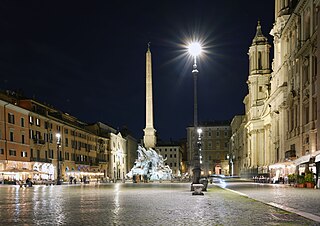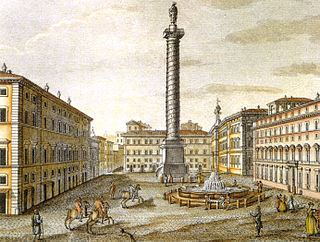
Giovanni Angelo Montorsoli, also known as Giovann'Agnolo Montorsoli, was a Florentine sculptor and Servite friar. He is today as often remembered for his restorations of famous classical works as his original creations.

Piazza Navona is a public open space in Rome, Italy. It is built on the site of the Stadium of Domitian, built in the 1st century AD, and follows the form of the open space of the stadium. The ancient Romans went there to watch the agones ("games"), and hence it was known as "Circus Agonalis". It is believed that over time the name changed to in avone to navone and eventually to navona.

Piazza di Spagna, at the bottom of the Spanish Steps, is one of the most famous squares in Rome, Italy. It owes its name to the Palazzo di Spagna, the seat of the Embassy of Spain to the Holy See. There is also the famed Column of the Immaculate Conception of the Blessed Virgin Mary.

Saint Peter's Square is a large plaza located directly in front of St. Peter's Basilica in Vatican City, the papal enclave inside Rome, directly west of the neighborhood (rione) of Borgo. Both the square and the basilica are named after Saint Peter, an apostle of Jesus whom Catholics consider to be the first Pope.

Borgo is the 14th rione of Rome, Italy. It is identified by the initials R. XIV and is included within Municipio I.

Piazza del Popolo is a large urban square in Rome. The name in modern Italian literally means "People's Square", but historically it derives from the poplars after which the church of Santa Maria del Popolo, in the northeast corner of the piazza, takes its name.

Via Margutta is a narrow street in the centre of Rome, near Piazza del Popolo, accessible from Via del Babuino in the ancient Campo Marzio neighborhood also known as "the foreigner's quarter". Mount Pincio is nearby. Via Margutta originally was home to modest craftsmen, workshops and stables, but now hosts many art galleries and fashionable restaurants.

The Fountain of the Naiads is a fountain in Rome, Italy, located at the centre of the Piazza della Repubblica on the Viminal Hill. The fountain was created by the architect Alessandro Guerrieri in 1888. Its four bronze sculptures of naiads created by Mario Rutelli were added in 1901 and Rutelli's central sculpture of the god Glaucus was added in 1912.

The Fontana della Barcaccia is a Baroque-style fountain found at the foot of the Spanish Steps in Rome's Piazza di Spagna. Pope Urban VIII commissioned Pietro Bernini in 1623 to build the fountain as part of a prior Papal project to erect a fountain in every major piazza in Rome. The fountain was completed between 1627 and 1629 by Pietro possibly along with the help of his son Gian Lorenzo Bernini, especially after his father's death on August 29, 1629.

The fountain in the Piazza d'Aracoeli is a fountain in Rome (Italy), located at the base of the Capitoline Hill, in the little square with the same name.

The fountain in the Piazza Colonna is a fountain in Rome, Italy, designed by the architect Giacomo Della Porta and constructed by the Fiesole sculptor Rocco Rossi between 1575 and 1577.

The Fontana del Pantheon was commissioned by Pope Gregory XIII and is located in the Piazza della Rotonda, Rome, in front of the Roman Pantheon. It was designed by Giacomo Della Porta in 1575 and sculpted out of marble by Leonardo Sormani.

Piazza della Repubblica is a circular piazza in Rome, at the summit of the Viminal Hill, next to the Termini station. On it is to be found Santa Maria degli Angeli e dei Martiri. It is served by the Repubblica – Teatro dell'Opera Metro station. From the square starts one of the main streets of Rome, Via Nazionale.

The Fountain of Neptune is a fountain in Rome, Italy, located at the north end of the Piazza Navona.

The Fontana delle Tartarughe is a fountain of the late Italian Renaissance, located in Piazza Mattei, in the Sant'Angelo district of Rome, Italy. It was built between 1580 and 1588 by the architect Giacomo della Porta and the sculptor Taddeo Landini. The bronze turtles around the upper basin, usually attributed either to Gian Lorenzo Bernini or Andrea Sacchi, were added in either 1658 or 1659 when the fountain was restored.

The Fountain of Neptune is a monumental fountain, located in Municipio square, in Naples, Italy. The fountain until the end of 2014 was located across the street of via Medina across from the church of Santa Maria Incoronata, Naples and a few doors south of the church complex of Pieta di Turchini. Now the fountain is located in front of the Town hill building, its location changed due to the construction of the new underground station.

The Fonte Gaia is a monumental fountain located in the Piazza del Campo in the center of Siena, Italy.

The Fountain of the Tritons is a fountain in Rome (Italy), Piazza Bocca della Verità, in front of the basilica of Santa Maria in Cosmedin. This fountain should be distinguished from the similarly named nearby Triton Fountain by Gian Lorenzo Bernini, in the Piazza Barberini, with only a single Triton.

The Fontana or Fontanone di Ponte Sisto, once known as the Fontanone dei Cento Preti, is an early 17th-century, monumental fountain now located in Piazza Trilussa, facing the south end of the Ponte Sisto, in Trastevere, Rome, Italy. It was reconstructed here in the late 19th century, originally erected across the river, attached to the former building of the Collegio Ecclesiastico.





















